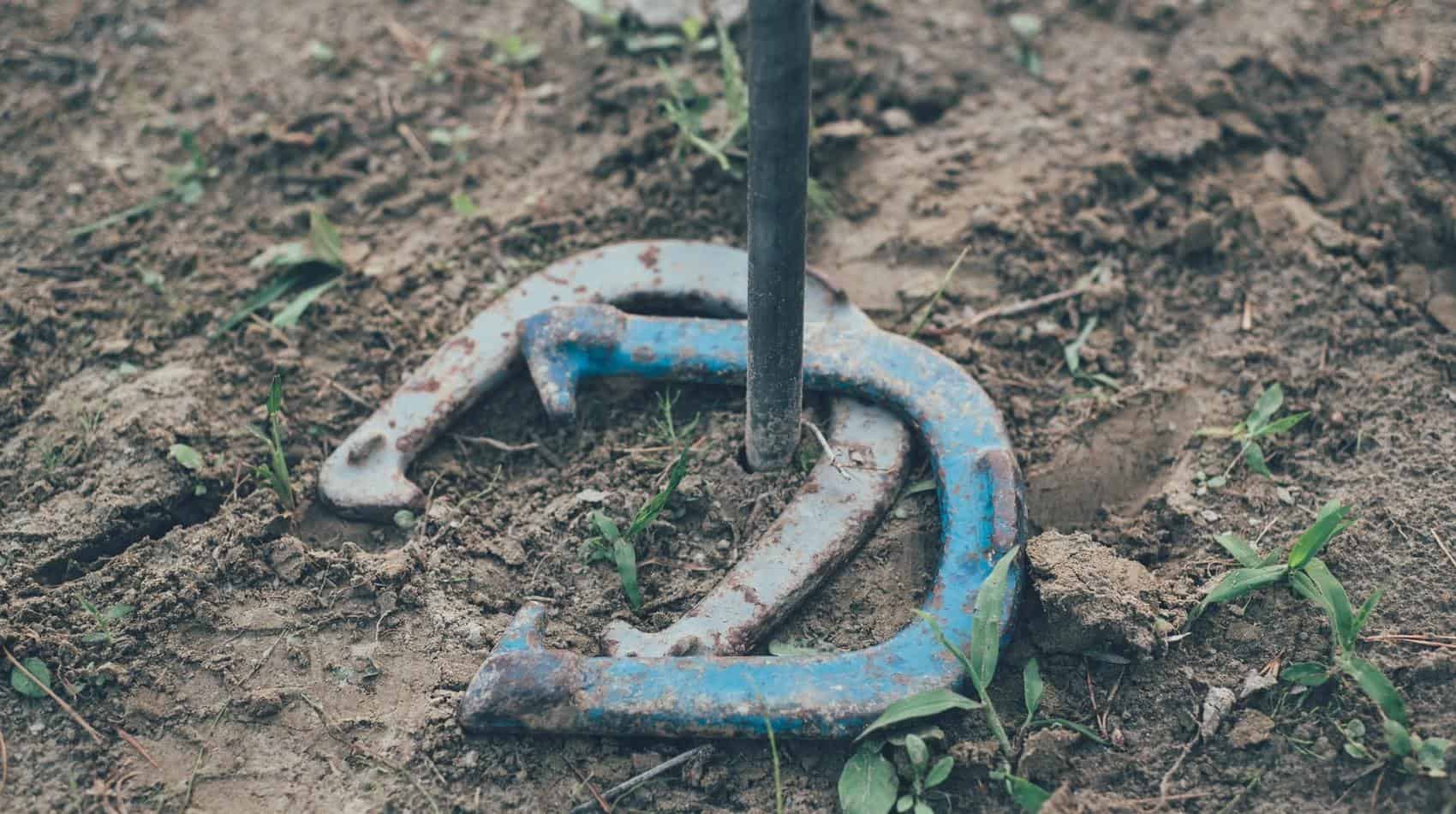Horseshoes has become a popular game, and those who take it a bit more seriously play it in tournaments. Then there are those of us who simply want some fun with our friends and family.
We pick up any horseshoe we can find, set up a court, and we are set. I know. This may sound absurd to those of you who are not familiar with how to play horseshoes. If you are part of the group, below we have an informational guide on how to play the game Horseshoes.
Requirements
Horseshoes– The game primarily requires four horseshoes evenly distributed among players. You can get a horseshoes set from a sporting store. The kit will typically come with horseshoes, stakes, and a carrying case. The width and length of the shoes shouldn’t be more than 7.25 and 7.6 inches, respectively.
It is best to have them color-coded to differentiate them. You can use plastic horseshoes for safety.
Stakes– They should be two and be one inch each. They must also be able to withstand recurring hitting by the horseshoes.
Something to record the scores– You can keep the scores by writing them down on a notepad, scoreboard, or anything that takes care of this requirement.
A court– You must have a place to play horseshoes. The chosen ground must meet certain specifications to have a realistic game, as you will see below.
Creating the Playing Court
1. Select a level and flat ground, and on it, drive the opposing stakes forty feet apart. The part of the stake that is exposed should be about 14-16 inches. You can have the stakes lean toward each other, but if not, they shouldn’t be leaning more than twelve degrees from the middle. Vertical stakes can also be used.
2. The next step is to make a horseshoe pit. You form it around both stakes, and the preferred pit size should be 3ft by 6ft long. Your stakes must be oriented in the middle of the pit. It is always best to mark the pit area then loosen the soil around it for the horseshoes to stay put after landing.
The pits can be of different sizes, with the width being between 31-36 inches and the length being between 43-72 inches. However, the best pit layout we recommend is ideally three by six feet.
3. Finally, draw the foul lines. Foul lines ascertain the distance players pitch from. You need to establish and draw two foul lines on both sides of your court. The first one will usually be a men’s foul line which should be about 37 ft from either stake. Experienced players can also use this foul line.
The other foul line should be 10ft ahead of the men’s foul line. This one is meant for women, children, elderly players, and beginners.
These foul lines indicate that men need to be throwing 37ft away from the target stake while the other mentioned players need to throw 27ft away.
How to Play
As mentioned earlier, horseshoes can be played casually or competitively. If you are playing a competitive horseshoes game, you play with pitching shoes. They look like ordinary horseshoes, but they are also made with a conventional style and design for peak performance.
Like any other game, playing horseshoes entails rules and follows specific criteria for gameplay.
You can play horseshoes alone, but where would the fun be? Play in a pair, two pairs, or more to compete and make the game more enjoyable. That way, you can have a player against a player or pairs against pairs. To determine the person or team that will pitch first, flip a coin.
Every player throws a horseshoe, what is referred to as “pitching.” The first player or team to pitch will usually throw the horseshoes one after the other. The other team then follows to pitch from the same end and still aims for the same stake.
You then tabulate the scores and retrieve the horseshoes for another round.
The team or person who is pitching next then throws from the opposite end toward the side that started the game.
Players pitch by alternating until when everyone has pitched. That establishes an “inning.” It is made from completed throws. Each pair of players or each player gets to pitch two horseshoes with every inning.
If the game is official, the maximum number of innings is 25, but you may have as many as you like if you are playing for fun.
Scoring
Horseshoes is even more enjoyable when you are winning. But how are the scores kept?
The closest horseshoe to the stake is the determiner of a score. It is the only shoe that can score a point. These close horseshoes are referred to as “live shoes.” The aim is usually to get the horseshoe to land within six inches from the stake or have it land and wrap itself around the stake.
- The horseshoe within 6 inches earns the player or team one point. More inches earn 0 points.
- The nearest horseshoe earns one point, not any other, except when the “live shoe” whose landing closely follows belongs to the same player.
- You earn three points when you get a ringer (when the horseshoe lands inside the stake to encircle it). If the same player or team gets two ringers, they earn six points.
- There are no points when a player or the teams get two ringers each. The game works through a cancellation policy. If two players or teams get a ringer each, they still cancel out, but the closest of the other shoes earns a point.
- If a player scores one ringer and their other shoe is still nearer the stake than the other three, they get three points for the ringer and an extra point for the close horseshoe.
When there are questions about ringers, a straight edge is used to determine the score. The straight edge is placed against the horseshoe’s open ends. If it doesn’t come into contact with the stake, the ringer qualifies.
There are times when the horseshoe touches a stake but doesn’t encircle it. That is referred to as a leaner. In an official game, getting a leaner earns a point, but it merits two points for amateurs.
You play the game until one team or player gets 40 points or whichever number you agreed on before the game begins. This is what is referred to as a point-limit game. You pitch shoes equal to the number. The player or team that gets the highest score first wins.
Breaking Ties
Any game ties must be broken, and it’s no different for horseshoes.
If the game ends with a tie, the first tie-breaking option is to have the game remain as a tie by giving every player a half loss and a half win. The other option is to keep playing until the tie is broken to attain an inning tiebreaker.
The Main Horseshoe Pitches
The Flip
Accustomed players on shorter courts mainly use this pitch. It gives more pitch consistency. This pitch is also used by recreational players when playing on a less than 40ft court.
You hold the horseshoe at the middle of its arch while keeping your thumb on top and gripping the inner edge with three fingers. The little finger stays on the side to offer support. Throwing flips the horseshoe while in the air.
The Reverse Flip
With this pitch, the arch of the horseshoe does not flip upwards but downwards. Your grip is usually similar to the one employed with a standard flip but in reverse. It is ideal for experienced players.
The ¾ Turn
To pitch, you hold the horseshoe such that the sides(shanks) point to the right as you flatly hold the shoe out on your front. Your thumb should be on top, while your little finger should be under for stability. The other fingers should ideally curl around the shoe’s inner edge.
After throwing, the horseshoe rotates counterclockwise.
The 1¼ Turn
This pitch is similar to the ¼ turn since it also aims at rotating the horseshoe for landing. However, when you throw the horseshoe, it rotates clockwise.
You hold the horseshoe such that the sides point to the left as you flatly hold it out to your front. Make sure to grasp the middle of the side. Your thumb should be on top, and you should have your three fingers curled around the edge of the inner side of the shoe. Your little finger should offer stabilization by being pressed below the horseshoe.
If you’re looking for some games you could inside with minimal effort/setup then you should check out our guide on Fun Group Cabin Games to Play Inside!
Final Thoughts
Horseshoes is a fun and engaging game that you can play when you are in the mood for competition. It is an excellent game for parties or for passing the time. Regardless of why or when you choose to play horseshoes, the aim is to win.
But winning requires you to be exceptional at the game. Use our guide to master the requirements, tricks, and rules if you are not.
My name is Eugene Thornhill. I'm an outdoor enthusiast who loves nothing more than being one with nature. I've lived in numerous outdoor homes and even constructed my own. Living off-grid is something I'm very familiar with, more so than living in the city. For many years I've dealt with the many problems of living off-grid. It's time to pass on my knowledge through Cabinguides.


